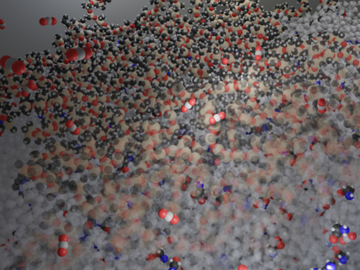
Filter News
Area of Research
- Advanced Manufacturing (3)
- Biology and Environment (6)
- Computational Engineering (1)
- Computer Science (6)
- Energy Science (11)
- Fusion and Fission (3)
- Fusion Energy (5)
- Isotopes (1)
- Materials (24)
- Materials Characterization (1)
- Materials Under Extremes (1)
- National Security (7)
- Neutron Science (5)
- Nuclear Science and Technology (7)
- Quantum information Science (3)
- Supercomputing (21)
- Transportation Systems (1)
News Type
News Topics
- (-) Advanced Reactors (9)
- (-) Artificial Intelligence (33)
- (-) Frontier (7)
- (-) Materials Science (31)
- (-) Nuclear Energy (18)
- (-) Quantum Science (16)
- (-) Security (5)
- 3-D Printing/Advanced Manufacturing (30)
- Big Data (14)
- Bioenergy (21)
- Biology (19)
- Biomedical (7)
- Biotechnology (8)
- Buildings (15)
- Chemical Sciences (26)
- Clean Water (7)
- Composites (10)
- Computer Science (46)
- Coronavirus (3)
- Critical Materials (7)
- Cybersecurity (8)
- Education (3)
- Emergency (1)
- Energy Storage (25)
- Environment (36)
- Exascale Computing (5)
- Fossil Energy (1)
- Fusion (11)
- Grid (13)
- High-Performance Computing (23)
- Hydropower (1)
- Irradiation (1)
- Isotopes (7)
- ITER (1)
- Machine Learning (14)
- Materials (40)
- Mathematics (2)
- Mercury (1)
- Microelectronics (1)
- Microscopy (7)
- Molten Salt (3)
- Nanotechnology (7)
- National Security (6)
- Neutron Science (32)
- Partnerships (23)
- Physics (9)
- Polymers (5)
- Quantum Computing (9)
- Simulation (15)
- Space Exploration (3)
- Statistics (1)
- Summit (9)
- Transportation (28)
Media Contacts

Researchers for the first time documented the specific chemistry dynamics and structure of high-temperature liquid uranium trichloride salt, a potential nuclear fuel source for next-generation reactors.

DOE commissioned a neutron imaging instrument, VENUS, at the Spallation Neutron Source in July. VENUS instrument scientists will use AI to deliver 3D models to researchers in half the time it typically takes.

A study by more than a dozen scientists at the Department of Energy’s Oak Ridge National Laboratory examines potential strategies to integrate quantum computing with the world’s most powerful supercomputing systems in the pursuit of science.

Researchers at ORNL have demonstrated that small molecular tweaks to surfaces can improve absorption technology for direct air capture of carbon dioxide. The team added a charged polymer layer to an amino acid solution, and then, through spectroscopy and simulation, found that the charged layer can hold amino acids at its surface.

Seven entrepreneurs comprise the next cohort of Innovation Crossroads, a DOE Lab-Embedded Entrepreneurship Program node based at ORNL. The program provides energy-related startup founders from across the nation with access to ORNL’s unique scientific resources and capabilities, as well as connect them with experts, mentors and networks to accelerate their efforts to take their world-changing ideas to the marketplace.

Prasanna Balaprakash, director of AI programs at the Department of Energy’s Oak Ridge National Laboratory, has been appointed to Tennessee’s Artificial Intelligence Advisory Council.
The contract will be awarded to develop the newest high-performance computing system at the Oak Ridge Leadership Computing Facility.

To better predict long-term flooding risk, scientists at the Department of Energy’s Oak Ridge National Laboratory developed a 3D modeling framework that captures the complex dynamics of water as it flows across the landscape. The framework seeks to provide valuable insights into which communities are most vulnerable as the climate changes, and was developed for a project that’s assessing climate risk and mitigation pathways for an urban area along the Southeast Texas coast.

Oak Ridge National Laboratory scientists have developed a method leveraging artificial intelligence to accelerate the identification of environmentally friendly solvents for industrial carbon capture, biomass processing, rechargeable batteries and other applications.

ORNL researchers completed successful testing of a gallium nitride transistor for use in more accurate sensors operating near the core of a nuclear reactor. This is an important technical advance particularly for monitoring new, compact.


